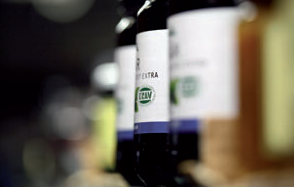Archive:Organic farming statistics — setting higher standards
- Published in Sigma - The Bulletin of European Statistics, 2010/01
Organic farming is an agricultural production method which places the highest emphasis on environmental protection and animal welfare considerations. It avoids or largely reduces the use of products authorised in conventional agriculture, such as synthetic pesticides, herbicides, chemical fertilisers, growth promoters such as antibiotics, and genetically modified organisms. For a number of years now, Eurostat has been collecting data on organic farming, yet a lot still remains to be done, as Marleen De Smedt, Ana Martinez Palou and Elisabeth Rohner-Thielen from the Health and Food Safety Unit at Eurostat told Sigma.
Introduction
‘We started collecting data on organic farming back in 1997,’ said Ms De Smedt, who headed the unit until 1 September 2009. ‘However, they were not perfect. As of 2000, we noted some improvements in the quality of statistics delivered to us, but even today many European Union (EU) countries do not produce separate data on organic agriculture. It is automatically considered to be part of conventional agriculture.’
Dynamic sector
However, existing statistics demonstrate that organic agriculture in the European Union is one of the most dynamic sectors characterised by a steady growth in size, today accounting for an estimated 7.2 million hectares of land and more than 180 000 certifi ed organic farms. Four per cent of the total utilised agricultural area in the EU is organic, accounting for more than 20 % of the world’s organic land.
European Union regulations stipulate that in order for the product to be certified as organic it has to be sown, in the case of crops, or reared, in the case of animals, on land that has been certified as organic for a period of at least two years. ‘According to EU regulations, organic land areas include both fully converted and “under conversion” areas,’ explained Ms Martinez Palou. ‘Italy, Germany and Spain have the largest parts of their arable land converted to the needs of organic farming.’
Organic production is strictly regulated under harmonised EU rules, which changed on 1 January 2009. The rules guarantee the authenticity of organic farming products wher ever they are produced and ensure that the labelling of these products is accurate. All foods sold as organic must come from organic operators who are registered with an approved control body and subject to regular inspections.
‘The certification and control bodies, which determine whether a producer is entitled to label their products as organic, are created and supervised by the Member States,’ said Ms Martinez Palou. ‘Three EU regulations from 2007 and 2008 specify the requirements and the procedures to follow, and apply to both crop and livestock farmers.’
More data needed
Eurostat collects and analyses the data compiled by the organic inspection and certification bodies in the EU. ‘As of 2005, separate statistics on organic farming can be found on our website,’ said Ms De Smedt. ‘They include data on organic crop areas, crop production and yields from fully converted areas, livestock and production of organic animal products, the number of registered organic operators as well as the number of registered operators processing and importing products issued from organic farming.’
In June 2007, Eurostat released a major report on the status of organic farming in the European Union in 2005. The report focused on the data from two areas which boast the most complete figures so far — the organic land area and the number of registered organic operators (producers, processors and importers).

‘Unfortunately, our knowledge in other fields is still incomplete and we are working hard to change this state of affairs,’ said Ms Rohner-Thielen. ‘Intensive work is going on the harmonisation of data to reach a common European format. New questionnaires prepared by an international task force involving Member States and led by Eurostat are currently being fine-tuned.’
In its work Eurostat relies heavily on the conventional farm structure surveys, where specifi c questions on organic farming had been inserted. ‘However, these surveys only take place every 10 years, with much smaller sample surveys of varying quality taking place in between, every two years,’ said Ms Rohner-Thielen. ‘We have also been using all the available food producer figures but we need to receive much more data than this.’
Big business
The market for organic products is expanding. Sales of organic products in Europe have been growing steadily and reached approximately EUR 16 billion in 2007. The largest shares of organic products in the EU in 2007 were recorded in Germany, followed by the UK, France and Italy.
‘All the available data suggest that in the foreseeable future the European organic market will continue to grow, with all organic producers being obliged to feature the new EU organic logo as required by the new labelling regulations as of 1 July 2010,’ said Ms De Smedt. ‘We are confident that our ever more comprehensive figures will continue to be useful to policymakers and consumers alike, and help raise the organic industry standards even higher.’


